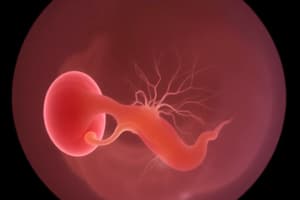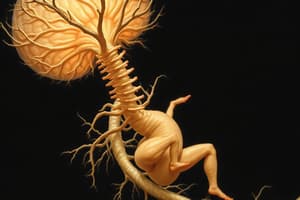Podcast
Questions and Answers
What is the first step in the process of neurulation?
What is the first step in the process of neurulation?
- Shaping and elongation of the neural plate
- Transformation of the central portion of the embryonic ectoderm into a thickened neural plate (correct)
- Bending of the neural plate around a medial groove
- Closure of the neural tube
At which stage does notochord development begin?
At which stage does notochord development begin?
- After the closure of the neural tube
- During gastrulation (correct)
- During the formation of the neural tube
- During neurulation
What is the role of the notochord during early development?
What is the role of the notochord during early development?
- To differentiate into vertebral bodies
- To signal the formation of the axial skeleton
- To induce the formation of the central nervous system (correct)
- To form the neural plate
Which of the following is NOT a stage of neurulation?
Which of the following is NOT a stage of neurulation?
What cell layer is primarily involved in the formation of the neural plate during neurulation?
What cell layer is primarily involved in the formation of the neural plate during neurulation?
What is the role of the neural tube after its formation during neurulation?
What is the role of the neural tube after its formation during neurulation?
When does the closure of the cranial neuropore typically occur during development?
When does the closure of the cranial neuropore typically occur during development?
Which of the following structures do neural crest cells NOT contribute to?
Which of the following structures do neural crest cells NOT contribute to?
What marks the completion of neurulation?
What marks the completion of neurulation?
Neural crest cells are often referred to as the 'fourth germ layer' due to their contribution to which of the following?
Neural crest cells are often referred to as the 'fourth germ layer' due to their contribution to which of the following?
Flashcards
Neurulation
Neurulation
The process of embryo development where the nervous system forms.
Notochord
Notochord
An initial, cellular rod forming the embryo's midline axis.
Neural Plate
Neural Plate
Thickened ectoderm that develops into the neural tube
Neurulation Stages
Neurulation Stages
Signup and view all the flashcards
Notogenesis
Notogenesis
Signup and view all the flashcards
Neural Tube Formation
Neural Tube Formation
Signup and view all the flashcards
Neuropores
Neuropores
Signup and view all the flashcards
Neural Crest Cells
Neural Crest Cells
Signup and view all the flashcards
Neural Crest Derivatives
Neural Crest Derivatives
Signup and view all the flashcards
Dorsal Root Ganglia
Dorsal Root Ganglia
Signup and view all the flashcards
Study Notes
Neurulation and Notogenesis
- Neurulation is a process where the embryo develops structures that become the nervous system in vertebrates. This involves the transformation of the neural plate into the neural tube.
- The embryo at this stage is called the neurula.
- The neural plate folds inward to form the neural tube, which develops into the spinal cord and brain.
- This eventually forms the central nervous system.
Notogenesis
- Notogenesis is the development of the notochord, a cellular rod, by epiblasts that form the floor of the amnion cavity.
- Notochord development starts during gastrulation (3rd week).
- Progenitor cells of the notochord migrate from the primitive node and pit.
- The notochord is a cellular rod that forms the first longitudinal midline axis around which vertebral bodies are organized.
- It is the basis for the axial skeleton.
- It is visible throughout the embryo, and around it are layered concentrations of cells that represent the primordia of future vertebral bodies.
Neurulation Stages
- Neurulation occurs in four stages.
- The central portion of the embryonic ectoderm thickens to form a neural plate.
- The neural plate shapes and elongates.
- The neural plate bends around a medial groove, with lateral folds elevating.
- The neural tube closes.
Notochord Induction
- Notochord induces the formation of the central nervous system (CNS).
- The notochord signals the ectoderm germ layer above it, causing it to thicken and form the neural plate.
- Cells of the neural plate are known as neuroectoderm.
- The induction of the neural plate is the initial event in neurulation.
Neural Tube Formation
- As the neural plate lengthens, its lateral edges elevate to form neural folds.
- The depressed midregion forms the neural groove.
- Neural folds approach each other in the midline and fuse, forming the neural tube.
- The neural tube eventually differentiates into the spinal cord and brain, forming the central nervous system.
- The cephalic and caudal ends of the neural tube communicate with the amniotic cavity through cranial and caudal neuropores, respectively.
- Cranial neuropore closure occurs around day 25.
- Posterior neuropore closure occurs around day 28.
Neural Crest Cells
- During neural tube formation, cells at the lateral border of the neuroectoderm dissociate from their neighbors.
- This cell population is called the neural crest.
- Neural crest cells undergo an epithelial-to-mesenchymal transition (EMT).
- They actively migrate and displace themselves into the underlying mesoderm.
- Neural crest cells are important for contributing to many organs and tissues and are sometimes considered a fourth germ layer.
- Neural crest cells give rise to diverse structures, including dorsal root ganglia, Schwann cells, autonomic nervous system components, meninges, sensory ganglia, bones of the face, teeth, lens of the eye, melanocytes, adrenal medulla, and many glands.
Studying That Suits You
Use AI to generate personalized quizzes and flashcards to suit your learning preferences.
Related Documents
Description
This quiz covers the processes of neurulation and notogenesis, key developmental stages in the formation of the nervous system and notochord in vertebrates. Learn about how the neural plate transforms into the neural tube and the significance of the notochord in establishing the axial skeleton.




